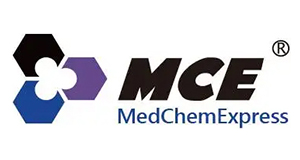Tamoxifen-d3, CAS 508201-30-7
Tamoxifen-d3, CAS 508201-30-7
SKU
MEXHY-13757AS1-1
Packaging Unit
1 mg
Manufacturer
MedChemExpress
Availability:
loading...
Price is loading...
Product Description: Tamoxifen-d3 is the deuterium labeled Tamoxifen[1]. Tamoxifen (ICI 47699) is an orally active, selective estrogen receptor modulator (SERM) which blocks estrogen action in breast cells and can activate estrogen activity in other cells, such as bone, liver, and uterine cells[2][3][4]. Tamoxifen is a potent Hsp90 activator and enhances the Hsp90 molecular chaperone ATPase activity. Tamoxifen also potent inhibits infectious EBOV Zaire and Marburg (MARV) with IC50 of 0.1 μM and 1.8 μM, respectively[6]. Tamoxifen activates autophagy and induces apoptosis[5]. Tamoxifen also can induce gene knockout of CreER(T2) transgenic mouse[7].
Applications: Cancer-programmed cell death
Formula: C26H26D3NO
References: [1]Russak EM, et al. Impact of Deuterium Substitution on the Pharmacokinetics of Pharmaceuticals. Ann Pharmacother. 2019 Feb;53(2):211-216./[2]Osborne CK. Tamoxifen in the treatment of breast cancer. N Engl J Med. 1998 Nov 26;339(22):1609-18./[3]Hawariah A, et al. In vitro response of human breast cancer cell lines to the growth-inhibitory effects of styrylpyrone derivative (SPD) and assessment of its antiestrogenicity. Anticancer Res. 1998 Nov-Dec18(6A):4383-6./[4]Jun Nagai, et al. Hyperactivity with Disrupted Attention by Activation of an Astrocyte Synaptogenic Cue. Cell. 2019 May 16177(5):1280-1292.e20./[5]Zhao R, et al. Tamoxifen enhances the Hsp90 molecular chaperone ATPase activity. PLoS One. 2010 Apr 15(4):e9934./[6]Kedjouar B, et al. Molecular characterization of the microsomal tamoxifen binding site. J Biol Chem. 2004 Aug 6279(32):34048-61./[7]Laura Cooper, et al. Screening and Reverse-Engineering of Estrogen Receptor Ligands as Potent Pan-Filovirus Inhibitors. J Med Chem. 2020 Sep 4./[8]Feil S, et, al. Inducible Cre mice. Methods Mol Biol. 2009530:343-63.
CAS Number: 508201-30-7
Molecular Weight: 374.53
Research Area: Cancer
Solubility: 10 mM in DMSO
Target: Apoptosis;Autophagy;Estrogen Receptor/ERR;HSP;Isotope-Labeled Compounds
Applications: Cancer-programmed cell death
Formula: C26H26D3NO
References: [1]Russak EM, et al. Impact of Deuterium Substitution on the Pharmacokinetics of Pharmaceuticals. Ann Pharmacother. 2019 Feb;53(2):211-216./[2]Osborne CK. Tamoxifen in the treatment of breast cancer. N Engl J Med. 1998 Nov 26;339(22):1609-18./[3]Hawariah A, et al. In vitro response of human breast cancer cell lines to the growth-inhibitory effects of styrylpyrone derivative (SPD) and assessment of its antiestrogenicity. Anticancer Res. 1998 Nov-Dec18(6A):4383-6./[4]Jun Nagai, et al. Hyperactivity with Disrupted Attention by Activation of an Astrocyte Synaptogenic Cue. Cell. 2019 May 16177(5):1280-1292.e20./[5]Zhao R, et al. Tamoxifen enhances the Hsp90 molecular chaperone ATPase activity. PLoS One. 2010 Apr 15(4):e9934./[6]Kedjouar B, et al. Molecular characterization of the microsomal tamoxifen binding site. J Biol Chem. 2004 Aug 6279(32):34048-61./[7]Laura Cooper, et al. Screening and Reverse-Engineering of Estrogen Receptor Ligands as Potent Pan-Filovirus Inhibitors. J Med Chem. 2020 Sep 4./[8]Feil S, et, al. Inducible Cre mice. Methods Mol Biol. 2009530:343-63.
CAS Number: 508201-30-7
Molecular Weight: 374.53
Research Area: Cancer
Solubility: 10 mM in DMSO
Target: Apoptosis;Autophagy;Estrogen Receptor/ERR;HSP;Isotope-Labeled Compounds
| SKU | MEXHY-13757AS1-1 |
|---|---|
| Manufacturer | MedChemExpress |
| Manufacturer SKU | HY-13757AS1-1 |
| Package Unit | 1 mg |
| Quantity Unit | STK |
| Product information (PDF) | Download |
| MSDS (PDF) |
|

 Deutsch
Deutsch







